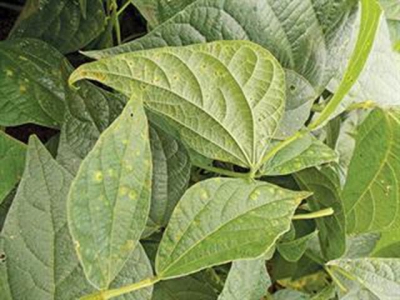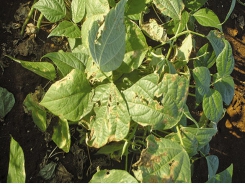Other important fungal leaf diseases in green beans

The most well-known fungal disease in beans is rust (Uromyces phaseoli). But it has become less of a problem due mainly to the emergence of resistant bean varieties.
Signs of bean rust: the light-coloured spots on the upper and lower leaf surfaces. Photo: Bill Kerr
Breeders now use two resistant genes in combination to ensure sufficient rust resistance. Highly effective systemic products are also available to make the disease easier to control. The first signs of rust are light-coloured spots, mainly on the underside of the leaves. These develop into pustules. The entire plant is affected, however, so the pods may also be unmarketable.
Usually, all that is required for the disease to appear is a susceptible variety and mild or cool weather conditions. On the Highveld, the disease first appears between the new year and winter. In subtropical areas, it becomes more severe towards spring, but appears throughout the growing season.
The fungus enters the plant through the stomata. After five days, the white spots appear. The brown pustules appear five to 10 days later. The spores released are spread mechanically and by wind. As soon as you see the light spots, spray a suitable systemic product, with a repeat application 10 days later. This should control the disease.
Angular leaf spot
This occurs sporadically, usually after a prolonged rainy period. The name describes the disease rather well: brown spots develop on the leaves and fill in the spaces between the veins, creating angular spots. The pods are also infected. The causal organism is Isarioposis griseola. This can overwinter in plant debris and can also be transmitted by seed, although this is seldom the case nowadays. The spores do not last long on infected debris. If the crop residue is fully decomposed it will be safe.
When infected leaves are turned over, you will see small black spots within the lesions. These are the spore-forming fruiting bodies.
Angular leaf spot can spread rapidly through a crop, so spray with a suitable systemic fungicide as soon as the first symptoms appear. Resistant green bean varieties are also available, with quite a difference in susceptibility between varieties in a trial when the disease appears.
Anthracnose
This is a highly destructive disease caused by the Colletotrichum lindemuthianum bacterium, which favours cool, wet conditions. It is brought in by infected seed and the disease manifests as reddish brown circular spots with light centres. Similar spots develop on the pods, which also become sunken.
I have come across anthracnose only once in the past 35 years. That was when viewing trials at a processor where a seed company had submitted a variety for evaluation. It was infected with the pathogen; all other varieties were clean. The disease is no longer a major threat as infected seed is rarely sold by seed companies.
If you do find it in your crop, ask your crop chemical representative for a fungicide to spray and keep that land free from beans for two years.
Sclerotinia
Sclerotinia sclerotiorum affects many different crops, so is fairly common. It shows up as a cotton wool-like fungus spreading throughout the plant and causing the tissue to become soft and then rot. Dark-coloured bodies form in this mass and harden.
Next season, small mushrooms develop from these sclerotia when there is a period of cool, rainy weather. When the weather clears, the mushrooms release millions of spores. These travel through the air and germinate on damaged tissue or even flowers that have started to wither after pollination.
Sclerotina can be very destructive, and it is best to avoid planting beans the year following a crop on which the disease was observed.
Related news
Tools

Phối trộn thức ăn chăn nuôi

Pha dung dịch thủy canh

Định mức cho tôm ăn

Phối trộn phân bón NPK

Xác định tỷ lệ tôm sống

Chuyển đổi đơn vị phân bón

Xác định công suất sục khí

Chuyển đổi đơn vị tôm

Tính diện tích nhà kính

Tính thể tích ao



 Some important green bean pests
Some important green bean pests  Avoid bacterial diseases in green beans
Avoid bacterial diseases in green beans